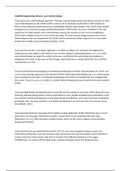Usability Engineering Lifecycle: user-centred design
I had used a user-centred design approach. The user-centred design ensures the service focuses on what
users need (Experience UX, 2019) and the system is to be designed specifically for older people are
likely to have different requirements due to disabilities faced by older people ( Tidy, 2016). Older people
recognise errors less than younger people (ScienceDaily, 2018) which can cause a problem in the user
experience for older people. User-centred design reduces the number of user errors ( Usability.gov,
2019) which mitigates the risk of user errors occurring. The user-centred design proposes the service
should adapt to the user (Experience UX, 2019) which could mean a better experience as many older
people have trouble using technology (Isolation, 2019).
I had used the star life cycle design approach, as it allows to utilise user evaluation throughout the
design process and adapts to the needs of users as they change (Computingstudents.com, n.d.). With
user centred design we adapt the system to the user, and the star life cycle design also believes in
adapting to the needs of the users as they change, which both have a similar belief that user and their
requirements are vital.
I had used evolutionary prototyping. Evolutionary prototyping is iterative (Researchgate.net, 2019), and
a user-centred design approach is also iterative (Public-media.interaction-design.org, n.d.), which means
they complement each other. Evolutionary prototyping also believes in keeping the user engaged with
the system (Teach-ict.com, n.d.) which is a similar belief of keeping the user involved in the user-centred
design.
I had used high-fidelity prototyping which seems like the live system to customers which allows for users
behaving naturally during testing, which would allow for more reliable feedback from participants. I had
also used low-fidelity prototyping as it stimulates group work (Babich, 2017) and I had been creating the
prototypes with my group members. Low fidelity prototyping is also fast and does not consume much
time (Babich, 2017).
I had used wireframes for the pages of the banking system (Rajnicant, 2019). Wireframes give a visual
appearance of web pages. Wireframes provide a visual which can be reviewed with users early
(Experience UX, n.d.) which provides usability testing, which can be used to improve the prototypes
during each iteration.
I had used the card sort method (olsen-landis, 2017) to carry out conceptual design to assess the
information architecture. Cart sort is cheap, quick and involves the users throughout which will help to
create a structure of the system, and what to include in the different interfaces of the pages
(Usability.gov, n.d.) which will be useful when creating prototypes and in the design process.
, There are limitations with the methodology, techniques and methods used, mainly due to time. A user-
centred approach could be difficult translating some data to design (Summertime Adventures Of
Information Design, 2013) which means that more time is used. If wireframes are too detailed it can be
time-consuming (Malone, 2017), in which if wireframes are skipped it can be quicker to get to the design
stage. Evolutionary prototyping needs changes often to meet all the user’ requirements
(Www2.latech.edu, 2003) which consumes much time. High fidelity prototyping consumes more time
compared to low fidelity due to its complexity, low fidelity is not an interactive prototype and does not
allow for user-driven interaction which does not allow for useful feedback from users.
In my Gannt chart (Appendix A) the tasks were mainly named by the activities used in the star life cycle
design. In star life cycle there is no order of activities (Computingstudents.com, n.d.) which means there
are no dependencies between the tasks from each iteration, although, in each iteration, the previous
iteration must be completed. I had mostly done different tasks in some of the iterations, although
conceptual design, prototype, requirement specification and their evaluations were included in each
iteration.





